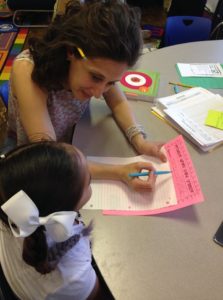Collaborative Classroom is honored to feature second-grade teacher Joanna Schwartz from Eliza B. Kirkbride Elementary School in Philadelphia, PA for this Teacher Spotlight.
 Tell us briefly about your classroom and how long you’ve been implementing Collaborative Literacy.
Tell us briefly about your classroom and how long you’ve been implementing Collaborative Literacy.
I teach second grade in a wonderful Title I school. This was my first year using material from the Center for the Collaborative Classroom. I have 27 students, including one student who visits us from an autistic support classroom. The majority of my students (about 75 percent) are English Language Learners from Asia and South or Central America. My school also works with a rigorous literacy support program called Children’s Literacy Initiative (CLI) to ensure all the elements of the demanding balanced literacy block are addressed.
This was also my first full year back in the classroom after taking a few years off to work as a child and family therapist and a professional developer, and Collaborative Literacy has been an invaluable resource for me.
What do you appreciate about Collaborative Literacy?
For the last several years, I have trained teachers in the fields of social and emotional learning, mindfulness, and resiliency. In my work, I have had the opportunity to research the soaring amount of teacher attrition in our country and to hear firsthand from teachers about the stress of teaching. I have seen that one of the factors that burn teachers out is the lack of quality resources and programs. Trying to both instruct and write quality curricula is tremendously taxing.
What I appreciate about Collaborative Literacy is that it provides teachers like me with a carefully crafted curriculum that allows us to blossom as professionals. Not only does it address the needs of ELL students and provide mentor texts and lessons that my students LOVE; it has also taught me how to lead group discussions, account for group dynamics, and be the kind of teacher I’ve dreamed of being.
“Not only does [Collaborative Literacy] address the needs of ELL students and provide mentor texts and lessons that my students love; it has also taught me how to lead group discussions, account for group dynamics, and be the kind of teacher I’ve dreamed of being.”
What have you noticed the students doing?
In my classroom, I have noticed that Collaborative Literacy’s structure allows my students to feel safe enough to express their opinions and to listen to others. To keep up with their increasing independence, I have added systems like “junior teacher,” where students are entrusted to lead transitions (from rug to carpet, to and from literacy centers, and in the line to lunch).
Students who would like to take their turn to speak in class will often kindly redirect others’ attention by saying to the class “I am waiting for your attention” if there are other students talking when it is their turn. I love the feeling of self-worth and community that this kind of accountable talk creates!
I have also noticed my students using our interactive literacy bulletin and publishing center. It contains materials for publishing (e.g., staplers, checklists, and a laminated book showing how to publish their work). The students also frequently grab how-to guides for writing in the genres we’ve covered, along with graphic organizers and samples of student work, as well as resources like dictionaries, thesauruses, and story starters.
Another success has been my students’ overwhelming love of the vocabulary aspect of the Making Meaning program. To promote their use of the new vocabulary words, students are encouraged to keep track of the times in the day when they hear the words, use them, and find them in texts. We keep a running tally by adding a cotton ball to a cup each time the words are used, and we have a celebration when the cup is full.
During a recent observation, my principal observed my students in art class where their teacher inadvertently used one of their new vocabulary words. The principal reported to me that my students “acted as though Beyoncé had just walked into the room!” If that doesn’t signify their love of the program, I don’t know what does!
